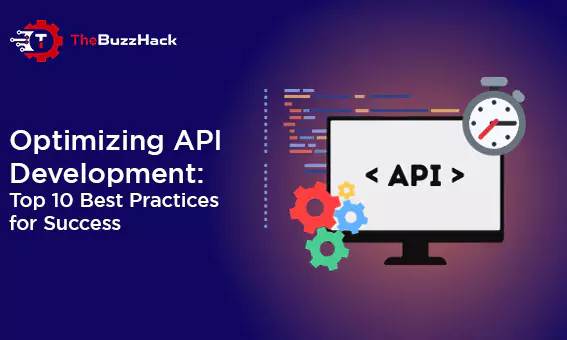
Optimizing API Development: Top 10 Best Practices for Success
APIs, or Application Programming Interfaces, constitute a vital element in contemporary software development. They empower developers to establish connections between diverse applications and systems, facilitating the exchange of data and functionality. APIs have become omnipresent in modern software development, influencing a spectrum ranging from mobile applications to enterprise systems.
Successful API development mandates a comprehensive grasp of both the technical and business requisites of the system under construction. This blog post delves into recommended practices for effective API development, aiming to fortify the triumph of your project.
Design First, Code Later
Commencing with API design prior to coding can yield savings in time and resources in the long term. Designing the API beforehand enables developers to pinpoint potential issues and bottlenecks early in the development phase, averting costly rework later on.
Tools like OpenAPI, Swagger, or RAML expedite the design process, providing a lucid specification for developers to reference throughout development. These tools foster collaboration among developers and stakeholders, ensuring the API aligns with the needs of both developers and end-users.
Maintain a Consistent and Clear API Structure
A uniform and transparent API structure is pivotal for ensuring ease of understanding and use. When crafting an API, developers should contemplate adopting a standard format for URLs, endpoints, methods, and parameters. This simplifies navigation and comprehension for developers.
Establishing a standard format for API responses, such as JSON or XML, streamlines data parsing and integration into applications. Alongside a consistent structure, offering perspicuous error messages proves crucial for aiding developers in troubleshooting issues.
Prioritize Security
Security must be a paramount concern during API development, given the frequent targeting of APIs by hackers. Secure communication protocols like HTTPS should be employed to encrypt data transmission between the API and other systems. Access controls like OAuth2 or JSON Web Tokens should be implemented to ensure only authorized users and applications access the API.
Conducting regular security audits and vulnerability testing is imperative to identify and rectify potential security vulnerabilities. This commitment to security ensures the safety of the API for both developers and end-users.
Ensure Scalability and Performance
Scalability and performance are critical considerations in API development. APIs must adeptly handle high traffic loads and scale with increasing demand. Techniques like caching and load balancing can be leveraged to distribute traffic and enhance performance.
Implementing rate limiting prevents API abuse, ensuring fair usage and preventing a single application from overwhelming the system. Regular monitoring and testing using tools like log analysis facilitate the identification and resolution of performance issues.
Provide Clear Documentation and Support
Clear documentation and robust support mechanisms are indispensable for enabling developers to effectively use the API. Comprehensive documentation should encompass examples, use cases, and API reference guides to facilitate understanding and issue resolution.
Support channels like email or chat offer valuable assistance to developers facing challenges or queries. Clear documentation and support foster a thriving community around the API, ensuring developers have the resources needed for successful application development.
In conclusion, adhering to these best practices for effective API development contributes to the creation of well-designed, secure, scalable, and user-friendly APIs. A design-first approach, coupled with a consistent API structure, security prioritization, scalability and performance optimization, and robust documentation and support, positions developers to craft resilient and accessible APIs. It is crucial to acknowledge that APIs are continually evolving, necessitating flexibility and adaptation to meet evolving needs. Collaboration among developers, stakeholders, and end-users is key to ensuring the API aligns with the diverse needs of all involved parties.
Moving on to the topic of IoT App Development Services:
In today’s digital era, the Internet of Things (IoT) has transformed our interaction with technology by connecting physical devices to the internet, facilitating communication and data exchange. This blog post explores the realm of IoT app development services, offering insights into their growing popularity and the benefits they bring to businesses.
Streamlining Operations with IoT Apps
IoT app development services have gained prominence as businesses recognize the potential advantages of connecting devices to the internet. These apps enable real-time data and analytics, empowering businesses to make informed decisions and enhance operational efficiency.
Task Automation for Efficiency
One notable benefit of IoT apps is their capability to automate tasks and processes. By linking devices to the internet, businesses can automate data collection, analysis, and reporting. This not only saves time and improves accuracy but also reduces the risk of human error.
Enhancing Customer Engagement
IoT apps contribute to improved customer engagement by collecting data on customer behavior and preferences. This data can be leveraged to create personalized experiences, such as targeted promotions and discounts based on purchasing habits.
Boosting Operational Efficiency
Real-time data and analytics provided by IoT apps enable businesses to identify and address inefficiencies in their operations. For example, manufacturers can optimize production lines and reduce waste by monitoring processes through IoT technology.
Choosing the Right IoT App Development Service
Selecting a scalable solution is crucial when opting for IoT app development services. The chosen development team should have the capability to create a solution that can grow in tandem with the business, accommodating the addition of new devices and features as needed.
Ensuring Reliability and Availability
Given that IoT apps rely on a network of devices and sensors, reliability and availability are paramount. The development team must guarantee that the solution remains robust, handling substantial data volumes and functioning even when some devices or sensors are offline.
In conclusion, the burgeoning field of IoT app development services provides businesses with tools to harness the transformative power of IoT technology. From task automation to enhanced customer engagement and operational efficiency, the benefits are multifaceted. When embarking on this journey, it’s essential to prioritize scalability, reliability, and the ability to adapt to the evolving needs of the business.
Read More: Mastering the Roadmap for Success


